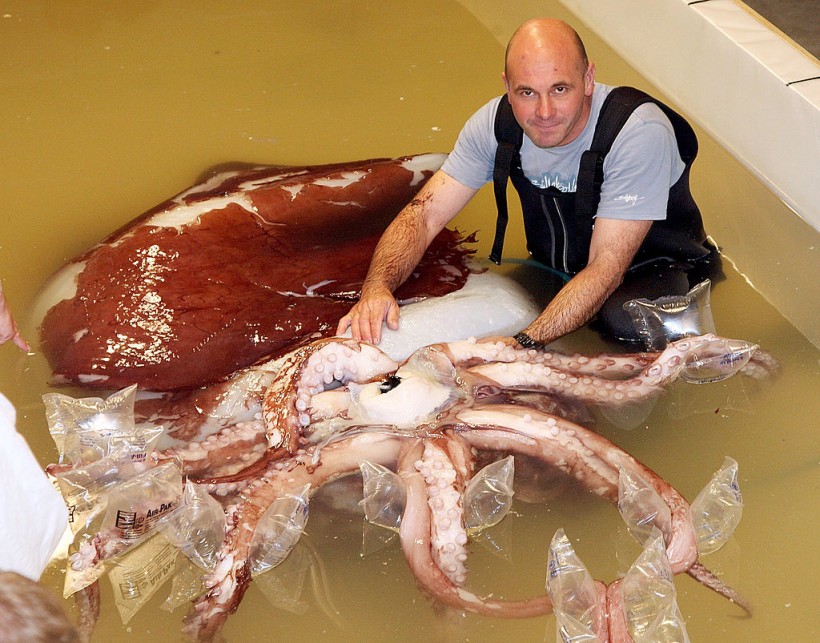The legend of the "Kraken" - the monstrously giant squid - has scared and intrigued humans for a long time, finding its way to countless books, films, and artworks. Now, a new study might have finally observed the closest thing we have to an actual Kraken - the giant squid.
While it has been depicted as sinking ships and pulling people away, the actual Kraken (or giant squid is technically known as Architeuthis dux) is actually camera-shy. Its "shyness" and elusiveness have made filming and documenting this species to be a challenging, near-impossible task for explorers, filmmakers, oceanographers, and more - until now.
To date, only Dr. Edith Widder from the Ocean Research and Conservation Association (ORCA) holds the distinction of being the only one to have repeatedly captured a living giant squid on camera.
As a result of all her efforts, together with her colleagues, they have revealed the secrets of the giant squid in the report "Studying the swift, smart, and shy: Unobtrusive camera -platforms for observing large deep-sea squid" appearing in the journal Deep Sea Research Part 1: Oceanographic Research Papers. Additionally, the free-to-access study also includes never-before-seen videos of the real-world Kraken.

WELLINGTON, NEW ZEALAND - APRIL 30: Lead Technician of Te Papa Mark Fenwick sits in the tank with a giant squid at the Te Papa Museum on April 30, 2008, in Wellington, New Zealand. The giant squid is currently defrosting to enable scientist to examine it, and it will in the future be put on display at the Museum.
ALSO READ: [VIDEO] Giant Squid Washed Ashore at South African Beach Stuns Beachgoers
A Shy, Gentle Giant
The giant squid, from the molluscan class of Cephalopods, is known as the world's largest invertebrate, growing up to lengths of 46 feet (14 meters). Although most of this length is from the squid's sinuous tentacles, the huge creature is not as easy to spot in the ocean as it should be.
Architeuthis dux generally lives in the waters 400 meters deep from the surface, where very small amounts of sunlight ever reach. To survive in this near-perpetual darkness, giant squids have adapted to their environment by developing very large eyes - the largest among any animal. Reaching diameters of 30 centimeters (almost 12 inches), the ruler-wide eyes of the giant squid are sensitive enough to see even with the faintest light. Researchers believe that they used these evolutionary adaptations to evade light from conventional underwater cameras and submarines people have previously used in attempts to film these creatures.
It prompted researchers to design an unobtrusive camera that would remain "invisible" to the visually acute cephalopods. Additionally, they had to find ways to lure these creatures close enough for filming. To solve this problem, Widder worked with the idea that while bright man-made lights could chase a giant squid away, a dimmer light similar to those deep-sea prey these cephalopods hunt could work as a lure. So they designed a lure, called E-Jelly, that mimicked the bioluminescence of deep-sea jellyfish (Atolla sp.)
Capturing a Giant Squid On Camera
Adding red light to the faint neon blue light of the artificial jellyfish bait, Widder's team was successful in filming the first known live footage of a giant squid - found in the waters of both the United States and Japan, across the Pacific.
Also, through the new unobtrusive camera technique, researchers were able to identify other species of squid, each being over a meter long, that they filmed across the Wider Caribbean Region.
The proven effectiveness of the unobtrusive camera platform could serve as the new standard to push studies around these elusive, little known species. Furthermore, these studies could help us better understand their behavior and population across the world's oceans, guiding conservation and preservation efforts in the future.
RELATED ARTICLE: Scientists Successfully Sequenced Giant Squid Genome
Check out more news and information on the Giant Squid in Science Times.














